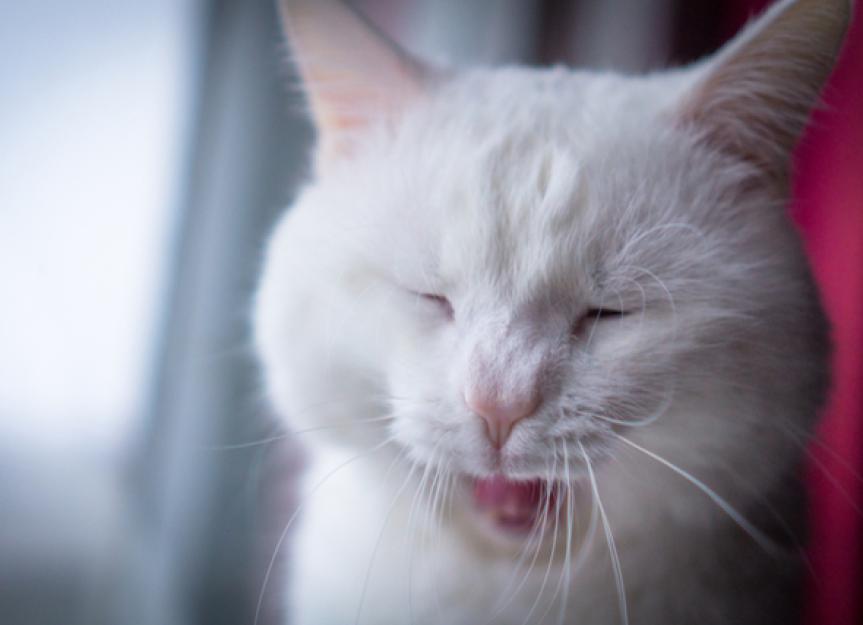Bad Breath in Cats: How to Prevent and Treat It
Cat breath is not supposed to smell like a bouquet. Something as mundane as a piece of tuna stuck between your feline companion’s teeth can produce a less-than-pleasant odor, says Dr. Bruce Gordon Kornreich, associate director of the Cornell Feline Health Center.
“It’s not necessarily abnormal for a cat to have a little odor in her mouth,” he says.
But if kitty’s breath consistently makes you wrinkle your nose, it could be a sign that something’s wrong. Here are some common causes of halitosis in cats, and ways to prevent and treat this condition.
Causes and Treatment of Bad Breath in Cats
Periodontal Disease
While many things can produce mouth odors, veterinarians agree periodontal disease is the most common cause of bad breath in cats. Periodontal disease is an infection that results from the build-up of soft dental plaque on the surfaces of the teeth around the gums, according to the Veterinary Oral Health Council. The bacteria in dental plaque irritate the gum tissue if plaque is allowed to build up, which can lead to infection in the bone surrounding the teeth. Within just a few days, plaque can mineralize and harden into tartar, which provides a rough surface that makes it easier for more plaque to accumulate.
If you ignore periodontal disease, it can lead to tooth loss, bleeding gums, pain, and other problems. To treat it, your cat should have a professional teeth cleaning at your veterinarian’s office, says Dr. Jennifer Marzec of City Cat Doctor, a feline veterinary practice based in Chicago.
Your pet will receive general anesthesia and, once sedated, the veterinarian will remove plaque and tartar from her teeth and check for any diseased teeth that may need to be extracted, Marzec says. In addition, X-rays may be taken.
Consistent oral hygiene can prevent periodontal disease from coming back. Brushing your pet’s teeth every day is the best thing you can do, says Marzec, who recommends introducing it in stages, since some cats resist having their teeth brushed.
“I think the most important tip is to go slow and work your way up to actually brushing with feline-specific toothpaste,” Marzec says. “First a cat should get used to you lifting her lip, then touching the teeth, then introducing the brush in the mouth, and finally the act of brushing. Going slow and offering positive reinforcement will increase the chances of success.”
(For more tooth brushing tips, check outthese step-by-step videosfrom the Cornell University College of Veterinary Medicine.)
如果刷牙是不可能的,擦拭你的猫’s teeth with dry gauze or a washcloth can help remove some plaque, Marzec says. Dental diets or treats can also reduce plaque build-up and freshen breath. She recommends products that have been accepted by theVeterinary Oral Health Council.
Lymphocytic Plasmacytic Stomatitis
In some cases, putrid breath is caused by a condition called lymphocytic plasmacytic stomatitis, which may be associated with feline leukemia virus, feline immunodeficiency virus, calicivirus, orBartonella,and other infections , says Dr. Marcia Landefeld of the Feline Veterinary Hospital in Port Washington, New York.
A couple of times every year, she sees kitties stricken with lymphocytic plasmacytic stomatitis, a serious inflammation of the mouth that causes odors and extreme pain. “The cat’s gums look like raw hamburger,” Landefeld describes. “Cats have sore, swollen, bleeding gums. It hurts when they open their mouths.”
Treatment can involve cleaning and removing some or all the teeth, she says. Cats with this condition may also need antibiotics.
In addition to chronic gingivitis and stomatitis, cats with the feline calicivirus may suffer from upper respiratory infections, characterized by discharge from the eyes, runny nose, sneezing, and ulcerations on the tongue, says Dr. Bruce Gordon Kornreich, associate director of the Cornell Feline Health Center. He recommends the calicivirus vaccine.
“疫苗会保护猫获得这disease,” he says. “The calicivirus is pretty transmissible to other cats and is very common in places with high concentrations of cats like shelters. It’s really important that people keep their cats up to date on vaccines.”
Oral Cancers
Oral cancers can also produce foul mouth odors, Kornreich says. As a tumor grows, it can become infected and cause halitosis.
“Unfortunately, by the time cats with squamous cell carcinoma [and other types of oral cancer] are diagnosed, the prognosis is not good,” says Kornreich, noting cats typically will only live two to six more months.
Kidney Disease
Sometimes, bad breath signals a health problem that originates outside of the mouth. If your cat’s breath smells like ammonia or urine, it could be kidney disease, which is not uncommon in cats ages 8 and older, Landefeld says. In addition to having bad breath, cats with kidney disease can appear lethargic, may experience weight loss, drink more water, and urinate more frequently and in greater volume.
“I’ve learned not to just look at the teeth,” Landefeld says. “I check kidney levels. That bad breath odor can mean toxins are building up.”
Your veterinarian can examine your pet and take a blood test and urinalysis to see if kidney disease is the problem.
Kidney disease can be managed with dietary modifications, such as minimizing the phosphorus content of food, making sure your cat is adequately hydrated, and dealing with secondary issues such as anemia or high blood pressure, says Kornreich.
“The earlier the stage of kidney disease, the better the prognosis,” he says.
Diabetes
If your cat’s breath has a fruity odor, it could indicate diabetes, especially if the animal is also drinking more water than usual, urinating more frequently, and losing weight despite having a ravenous appetite, Landefeld says. Diabetes in cats can be managed with insulin.
Liver Disease
In addition to foul-smelling breath, a cat with liver disease may have yellowing of the whites of the eyes or yellowing of the skin on the ears or on gums, Kornreich says. She may also be lethargic, have a poor appetite, vomiting or diarrhea, and drink and urinate more than normal. Treatment depends on the cause of liver disease, he says.
Diagnosis of Bad Breath in Cats
To determine the cause of your cat’s halitosis, a veterinarian will start by taking a complete health history and performing a physical examination. If the origin is not obvious (e.g., periodontal disease, lymphocytic plasmacytic stomatitis, or an oral tumor), he or she will then search for an underlying medical problem by running blood work, a urinalysis, and any other diagnostic tests that might be necessary.
Read more:Bad Breath (Chronic) in Cats

